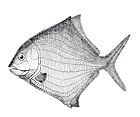|
Mamulichthys
Mamulichthys is an extinct genus of prehistoric bony fish that lived during the Urzhumian age (Guadalupian/middle Permian epoch) in what is now European Russia (Orenburg Oblast).[1][2] The type and only species, Mamulichthys ignotus, is known from a single specimen preserving the skull and anterior body portion, which was recovered from the uppermost part of the Amanak Formation.[1] Holotype of M. ignotus is the first complete skeleton of discordichthyiform.[2] DescriptionOperculum is large and rounded. On the ventral side there are longitudinal rows of large and massive crescent-shaped scales, overlapping each other. All dermal bones have hollow tubercles of various shapes and sizes. The lateral scales are high. The spines of the dorsal and pectoral fins are large.[1] ClassificationTogether with Discordichthys, Geryonichthys, and Mutovinia, Mamulichthys is placed in the family Discordichthyidae in the monotypic order Discordichthyiformes. They are endemic to the Permian of European Russia and characterized by their peculiar skull morphology, and the presence of dorsal and pectoral fin spines (two of each).[1] They could be stem Actinopterygii, relict forms that survived into the Permian. See alsoReferences
|
||||||||||||||||||||||||||||








